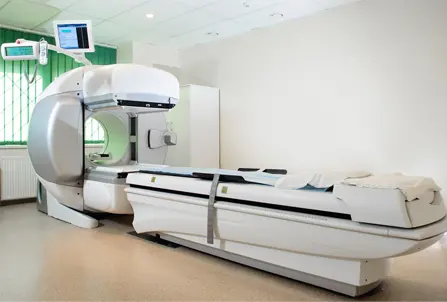What is Nuclear Medicine?
Nuclear medicine is a branch of medicine involving the use of radioactive substances in the diagnosis and treatment of diseases. These include, but are not limited to, the treatment of cancer, heart disease, endocrine disease, gastrointestinal disease, and neurological disorders. It offers the potential to recognize diseases in their earliest stages by pinpointing molecular activity often before symptoms occur or other abnormalities can be detected using alternative diagnostic tests. It even allows medical providers the ability to identify a patient’s immediate response to some treatments.
What are Medical Isotopes?
Medical isotopes are radioactive substances used in the diagnosis and treatment of diseases. The energy emitted by these radioactive substances can be detected using special cameras and imaging software that helps evaluate organ size, location, and function. In treatment some radioactive substances can be used to destroy harmful cells or tumors.
How Are Medical Isotopes Made?
The majority of medical isotopes are made in nuclear reactors with some being produced in cyclotrons. The isotopes that are neutron-rich and those created from nuclear fission must be made in nuclear reactors. To date we use roughly 40 activation product radioisotopes and also 5 isotopes that are products of fission in reactors.
List of Medical Isotopes Produced in Reactors and Their Uses:
Bismuth-213
Bismuth-213 is used in cancer therapy, specifically targeted alpha therapy (TAT). It has a high level of energy producing 8.4 MeV and has a half-life of 46 minutes.
Caesium-131
Caesium-131 provides soft x-rays which makes it suitable for brachytherapy. It has a half-life of 9.7 days.
Caesium-137
Caesium-137 has a lower level of energy. It has a half-life of 30 years and is commonly used for the sterilization of blood products.
Chromium-51
Chromium-51 is most regularly used to quantify the loss of gastro-intestinal proteins or to quantify blood loss. It is also used to label and monitor red blood cells. It has a half-life of 28 days.
Cobalt-60
Cobalt-60 is most commonly used for sterilizing and to treat brain cancer. It has a half-life of 5.27 years.
Dysprosium-165
Dysprosium-165 is used in the arthritis treatment known as synovectomy. It is used to aggregate hydroxide in the arthritis treatment process. It has a half-life of 2 hours.
Erbium-169
Erbium-169 is used for pain relief in the synovial joints associated with arthritis. It has a half-life of 9.4 days.
Holmium-166
Holmium-166 is primarily being used for the diagnosis and treatment of liver cancer and tumors. It has a half-life of 26 hours.
Iodine-125
Iodine-125 is commonly used to diagnose deep vein thrombosis (DVT), measure trace hormones, and to measure the kidney’s filtration rate. It is also used for brain and prostate brachytherapy. It has a half-life of 60 days.
Iodine-131
Iodine-131 is regularly used to evaluate the kidney’s blood flow, evaluate liver function, and diagnose urinary tract obstruction. If is also used to gather images of the thyroid and to treat thyroid cancer. While it is used for beta therapy it is also a strong gamma emitter. It has a half life of 8 days.
Iridium-192
Iridium-192 is used in prostate cancer and is a strong beta emitter. It generally comes as a wire to for use in internal radiotherapy. It has a half-life of 74 days.
Iron-59
Iron-59 is used to evaluate the metabolism of iron in the spleen. It has a half-life of 46 days.
Lead-212
Lead-212 is used to treat breast cancer, melanoma, and also ovarian cancer through alpha radioimmunotherapy and targeted alpha therapy (TAT). It has a half-life of 10.6 hours.
Lutetium-177
Lutetium-177 is used for simultaneous imaging and treatment of small endocrine tumors. It has a half-life of 6.7 days.
Molybdenum-99
Molybdenum-99 is used to help create technetium-99m. It has a half-life of 66 hours.
Palladium-103
Palladium-103 emits soft x-rays and is used to treat prostate cancer in it’s early stages through brachytherapy. The brachytherapy implant seeds using Palladium-103 are generally permanent. It has a half-life of 17 days.
Phosphorus-32
Phosphorus-32 is used to treat those with a condition that results in excess red blood cells known as polycythemia vera. It is a beta emitter and has a half-life of 14 days.
Potassium-42
Potassium-42 is used to measure the level of exchangeable potassium in the heart’s blood flow. It has a half-life of 12 hours.
Radium-223
Radium-223 emits soft x-rays and is used primarily for brachytherapy. It has a half-life of 11.4 days.
Rhenium-186
Rhenium-186’s weak gamma rays are used for imaging. It is also a beta emitter. It is commonly used to treat pain in patients suffering from bone cancer. It has a half-life of 3.8 days.
Rhenium-188
Rhenium-188 is used to beta radiate the arteries of the heart after an angioplasty balloon. It has a half-life of 17 hours.
Samarium-153
Samarium-153 is regularly used to treat the pain of secondary cancers found in patient’s bones and also for breast and prostate cancer. It is a beta emitter with a half-life of 47 hours.
Selenium-75
Selenium-75 is used to evaluate digestive enzyme production. It has a half-life of 120 days.
Sodium-24
Sodium-24 is used to evaluate the body’s electrolytes. It has a half-life of 15 hours.
Strontium-89
Strontium-89 is used to treat pain in both bone and prostate cancer. It is a beta emitter with a half-life of 50 days.
Technetium-99m
Technetium-99m is the most commonly used radioisotope used in scans making up over 80% of all related diagnostic imaging. It is used for imaging the cardiac muscle and patient’s skeleton. It is also used to gather images of the liver, spleen, brain, lung, thyroid, bone marrow, gall bladder, salivary glands, lacrimal glands, infection, heart blood pooling, and other specialized studies. It is produced in a generator from Mo-99 and has a half-life of 6 hours.
Xenon-133
Xenon-133 is used for studies related to pulmonary function and ventilation. It has a half-life of 5 days.
Ytterbium-169
Ytterbium-169 is used for studies in the brain related to cerebrospinal fluid. It has a half-life of 32 days.
Ytterbium-177
Ytterbium-177 is the progenitor of Lutetium-177 and has a half-life of 1.9 hours.
Yttrium-90
Yttrium-90 is used as a silicate colloid for the treatment of pain in large synovial joints of patients with arthritis. It is also used in the brachytherapy of cancer patients. It is a pure beta emitter and has a half-life of 64 hours.
List of Medical Isotopes Produced In Cyclotrons and Their Uses:
Carbon-11
Carbon-11 is a positron emitter commonly used for PET scans. These types of scans are regularly used for brain scans to evaluate pathology and physiology.
Cobalt-57
Cobalt-57 helps physicians estimate the size of organs and also helps with in-vitrio diagnosis. It has a half-life of 272 days.
Copper-64
Copper-64 helps is the diagnosis and study of different genetic diseases related to the body’s ability to metabolize copper. It is also used for cancer therapy and for PET scans of different types of tumors. It has a half-life of 13 hours.
Copper-67
Copper-67 is a beta emitter commonly used in therapy. It has a half-life of 2.6 days.
Fluorine-18
Fluorine-18 is a positron emitter that is commonly used to diagnose cancer, malignant tumors, and also to evaluate the effectiveness of treatments. It has a half-life of 110 minutes.
Gallium-67
Gallium-67 is regularly used to track inflammatory lesions and infections. It is also sued for tumor imaging. It has a half-life of 78 hours.
Gallium-68
Gallium-68 is a positron emitter produced from germanium-68. It is regularly used in both PET and PET-CT scans. It has a half-life of 68 minutes.
Germanium-68
Germanium-68 is primarily used as the parent in creating Gallium-68. It has a half-life of 271 days.
Indium-111
Indium-111 is used for tracking cancer, inflammation, and blood clots. It is also used for diagnosing brain and colon cancer. It has a half-life of 2.8 days.
Iodine-123
Iodine-123 is a gamma emitter with no beta radiation. It is regularly used for evaluating thyroid function.
Iodine-124
Iodine-124 is a part positron emitter often used for PET scans. It has a half-life of 4.2 days.
Krypton-81m
Krypton-81m is used for the diagnosis of lung disease and pulmonary function. It has a half life of 13 seconds.
Nitrogen-13
Nitrogen-13 is a positron emitter regularly used for PET scans. Nitrogen-13 has a half-life of 10 minutes.
Oxygen-15
Oxygen-15 is a positron emitter also regularly used for PET scans of the brain. It has a half-life of 2 minutes.
Rubidium-81
Rubidium-81 is also commonly used to diagnose lung function and pulmonary disease. It has a half-life of 4.6 hours.
Rubidium-82
Rubidium-82 is regularly used in PET scans to evaluate cardiac perfusion. It has a half-life of 1.26 minutes.
Strontium-82
Strontium-82 is used to create Rubidium-82. It has a half-life of 25 days.
Thallium-201
Thalium-201 is used to find lymphomas and is also used to diagnose coronary heart disease. It has a half-life of 73 hours.
How is Nuclear Medicine Used to Diagnose Diseases?
Nuclear medicine imaging procedures use small amounts of medical isotopes called radiotracers that are commonly placed into a patient’s blood stream, swallowed, or inhaled. These radiotracers travel through the body while sending off gamma rays that are detected using a special camera providing diagnostic images of the surrounding tissue. Imaging procedures done through nuclear medicine are noninvasive, with the exception of imaging done through intravenous injection. The imaging procedures are also generally painless and can provide detailed molecular information.
Other imaging techniques are commonly combined with nuclear imaging to give doctors a better diagnostic understanding of the targeted tissue and it’s molecular function. Computed tomography (CT) and magnetic resonance imaging (MRI) are two examples of imaging techniques that can be superimposed over nuclear images. As a result, the combined images allow for information to be correlated and then interpreted precisely by the diagnosing physician. The technique of superimposing the different types of images has been so successful that they have started to build machines that combine both CT and nuclear imaging. These are known as single emission computed tomography/computed tomography (SPECT/CT) and also position emissions tomography/computed tomography (PET/CT).
How is Nuclear Medicine Used in Therapy?
Nuclear medicine also provides therapeutic procedures for specific diseases. Over 40 million nuclear medicine procedures are performed annually with the demand for medical isotopes increasing 5% each year. Fundamentally, medical isotopes are used to target and destroy harmful cells in the body. An example of this is Non-Hodgkin’s lymphoma being treated using radioimmunotherapy (RIT). Radioimmunotherapy combines the specificity of the immune system with the power of radiation therapy. Also, those with cancer affecting their thyroid gland can be treated using radioactive iodine (I-131) therapy. Some medical isotopes are better than others for the treatment of disease based upon the type of radiation they emit and their half-life.
Learn more about the medical education and certificates we offer here at United Medical Education. We provide continuing medical education (CME) and emergency medical certifications required by most healthcare professionals.






